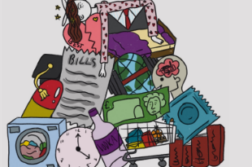According to the Crown Prosecution Service, domestic abuse is defined as ‘any incident of controlling, coercive or threatening behaviour, violence or abuse between those aged 16 or over who are or have been intimate partners or family members, regardless of their gender or sexuality.’
Domestic abuse comes in many forms, and is a lot more complicated and widespread than the media might lead you to think. Alongside physical violence, the Government defines the following actions as domestic abuse:
- financial abuse (controlling your partner’s finances and preventing them from having financial independence)
- sexual abuse (rape, sexual assault, revenge porn and coercing your partner into sexual acts)
- psychological abuse
- emotional abuse
- coercive control (which became a criminal offence in 2015)
The National Prevalence of Domestic Abuse
However, although 1,198,094 incidents of domestic abuse were recorded by the police, only 68,098 (5.68%) of these led to a successful conviction. Consequently, considering these extremely low conviction rates, is it really any surprise that so many domestic violence cases go unreported?
Although the number of recorded domestic abuse incidents is just over a million, there is an estimated 2.4 million adults who live with domestic abuse. Note the discrepancy between these two figures – it suggests that approximately 1.2 million adults suffer abuse in silence, never bothering the report their struggles to the police. But with conviction rates in the UK being so low, this lack of reporting is hardly surprising.
Indeed, domestic violence charity Refuge points to many systematic failures that contribute to the growing national prevalence of domestic abuse. Refuge themselves report that they have received cuts to 80% of their services since 2011, with some funding being cut by 50%. Furthermore, since 2010, this country has lost 17% of its specialist domestic violence units.
What makes it worse is that as well as domestic abuse victims having less resources to turn to, the resources they have left are not doing enough. Before receiving effective help to stop the abuse, 85% of abuse victims sought help from professionals an average of five times. Although the police receive domestic violence-related calls every 30 seconds, only 8% of domestic abuse cases end in prosecution.
Domestic Abuse in Southampton
But how does Southampton come into this? Unfortunately, Hampshire is one of the worst area in the UK for domestic abuse cases. In 2017/18, Hampshire (Southampton inclusive) reported 21.9 domestic violence incidents per 1000 people.
This is higher than the South East average, which reported only 20.o cases per 1000 people. Indeed, 30% of all violent crime reported in Southampton had a domestic abuse element. Whilst 1,430 domestic abuse incidents were reported in 2010/11, there has been a steady increase over the last seven years, with the latest data showing that the number of domestic abuse crimes stands at 3,031. This shows that the rate of domestic abuse cases has more than doubled in less than a decade.
Furthermore, research by SafeLives shows that Southampton has an abnormally high level of ‘high risk’ domestic violence cases. ‘High risk’ refers to cases where the domestic violence victim is at risk of ‘serious harm and death’ at the hands of the abuser. In a city like Southampton, there should only be 45 high-risk cases per a population of 10,000. However, this number actually stands at 80.3 high-risk cases per a population of 10,000 – again, almost double what it should be.
What makes this worse is that 13.5% of all recorded crime in Southampton was flagged as domestic in 2018/19, which marked a 13.1% increase of such crime compared to the year before. In turn, if we look at violent crime specifically, 31.5% of all violent crime in Southampton was marked as domestic in 2018/19 – which was a 15% increase in comparison to the previous year.
Risk Factors
Statistics shows that a low income, low educational levels, a lack of education and being of a young age are all factors in people becoming domestic abuse perpetrators.
Indeed, with Southampton being home to two different universities, 20% of the city’s population is classified as young people (aged 15-24). This rate is significantly higher than the national average, and with young people being more likely to become abusers partly due to their own upbringing and inexperience, this then causes domestic abuse to be more common in Southampton.
Southampton is also a city with high levels of deprivation, with it being ranked the 67th most deprived local authority area in England (out of 326). Indeed, with deprivation encompassing many of the aforementioned risk factors like unemployment and low income, it should come as no surprise that domestic violence is eight times higher in the 20% most deprived areas than in the 20% least deprived. This then suggests that the levels of deprivation as well as the high number of young people are both contributing factors to the problem of domestic abuse in Southampton.
How Southampton are Tackling Domestic Abuse
So, given we have established that Southampton has especially bad levels of domestic abuse, the next question we should consider is this – what are the council doing about it?
In summer 2018, Southampton City Council took part in the Chartered Institute of Housing’s ‘Make a Stand’ campaign, which involves the council’s Housing Service pledging to take action against domestic violence in the city. Seventeen members of the Housing Service also trained as Domestic Abuse Champions in order to support residents of their properties in need.
Furthermore, in January 2019, Southampton launched a public review on how to tackle domestic abuse in the city. A series of public scrutiny panel meetings took place over the spring of 2019, which culminated in the council releasing a detailed Domestic Abuse Needs Assessment in June of that year, which based its research on the issues raised in these meetings and made recommendations on how to solve the problem moving forward.
All of this work led to the city receiving Domestic Abuse Housing Alliance accreditation in December 2019 (making them only the third local authority to do so). This prestigious accreditation acknowledged their commitment to supporting domestic abuse victims, but the question is, has all this work translated into results? Until the 2019/2020 statistics come out, we can’t know for sure – but they’re certainly taking steps in the right direction.




